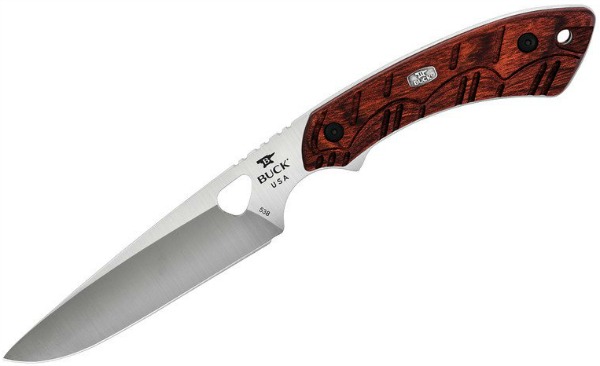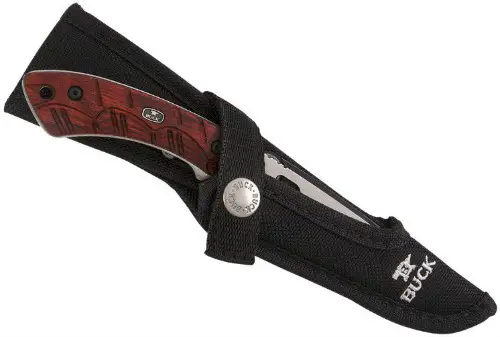|
Buck Model 538 Open Season Small Game Knife By Gary Zinn  Illustration courtesy of Buck Knives. The fixed blade hunting knives long made by Buck Knives (buckknives.com) are quite familiar to older hunters and outdoorsmen. The Buck Pathfinder, Woodsman, etc., are distinctive and well regarded for their design, function and durability. These Buck Classic Fixed Blade Hunting Knives are among the few traditional outdoor knife designs that have endured to the present day. They and the Buck Model 110 lock back folder epitomize the term "Buck knife." In just the last few years, Buck has launched a new Open Season line of knives. Currently, there are two sets of Open Season knives, labeled the Pro Series and the Avid Series. The Pro Series knives feature S35VN blade steel and micarta handles, while the Avid Series knives are made with 420HC steel and have handles of thermoplastic material. There are over a half dozen models or variants in each series. The subject of this review is the Model 538 Small Game knife, in Avid Series configuration. (The Model 539 is the Pro Series version.) I thank the good folks at Buck Knives for providing the review knife. Specifications
I found much to like about the design and size of this knife. It is one of the smaller knives in the Open Season series and would not be the tool of choice for field dressing a mastodon. It will serve well, though, for more mundane (and likely) tasks. It has the characteristics I look for in a general purpose field knife; it is simple, tough, compact and versatile. All of the Open Season fixed blade knives are simple, in that they feature full tang blades with handle scales attached to the tang with cross bolts and cap screws. There are no other items of "furniture" added on. The only thing simpler is a skeleton handle or self handle. A full tang, faced with virtually indestructible handle scales, equals a tough knife. Any knife can be damaged via abuse or severe mishap, but a full tang fixed blade knife with sturdy handle material makes for a high degree of strength and durability. Compact is a relative term. My dimensional criteria for a general purpose field knife include a blade with 3-1/4 to 3-1/2 inches of cutting edge, a handle that is at least four inches long and a weight of five ounces or less. The Small Game has a 3-3/8 inch blade, 4-1/16 inch handle (including the finger choil) and weighs 2.75 ounces (4.5 ounces with the sheath). I like these dimensions. The knife is light in the hand and on the belt, the working length of the blade is sufficient for most outdoor cutting tasks and the handle is just long enough for a full-fisted grip with my medium-large hand. Versatility is a function of blade size and geometry, complemented by good handle ergonomics. To me, a general purpose field knife should be efficient at field dressing and skinning deer, cleaning small game, fish and doing any number of other cutting chores. A drop point blade profile is a very good (and popular) choice in outdoor knives, because drop point knives generally have this kind of versatility. My only reservation about the blade profile of the Small Game knife is it is a bit more slender than the norm for drop points and therefore does not have quite enough curve in the belly to be highly efficient as a skinning knife. The satin finished blade sports the characteristic Buck high hollow grind, with the final sharpened edge formed by a narrow micro bevel. The factory edge easily made my top qualitative rating of sharpness, Extremely Sharp. The steel is 420HC stainless, a long time mainstay in the Buck product line. Steel freaks may judge 420HC unfavorably in this age of super steels, but it remains a blade steel of proven performance and it sharpens easily. Anyone who wants a premium steel in a Buck Open Season knife can opt for something from the S35VN line (e.g., the Model 539), at about twice the price of the equivalent knife with 420HC. The blade is 3mm (0.12 inch) thick at the spine. It tapers from 15/16 inch wide just forward of the finger choil to 3/4 inch wide at the midpoint, then tapers more rapidly to the tip. This continuous, increasing taper accounts for the lack of a pronounced belly in the blade. There is a small area of jimping on the spine, just forward of the choil. This is nice if one wants to use the knife with a thumb-on-top power grip. There have been some confused quotations of both blade and handle length. Facts: the useable working length of the handle is 4-1/16 inches, measured from the butt to the lip of the finger choil. The sharpened edge of the blade is 3-3/8 inches long, while the overall length of the knife is 7-9/16 inches. The handle scales are 3-1/2 inches long, so they do not fully cover the finger choil area; this, I think, is the cause of the conflicting length measurements. Buck has hit a home run with the Open Season handle design. The handle profile looks modern and stylish. More importantly, the handle shape is quite ergonomic, so Open Season knives feel secure, handle deftly and can be worked hard without hand fatigue. My introduction to the Open Season handle design was on the Buck Model 550 Selector 2.0 Folding Knife. I was impressed with the feel of the handle right away and handling the Selector and subsequent Open Season knives has reinforced that impression. These knives have better ergonomics than most of the current generation of new knife designs. Handles are sized in proportion to the length and bulk of blades, so there are no universal measurements of handle dimensions for the Open Season knives. The Small Game and Caper are the smallest knives, so their handles are somewhat more svelte than those of larger knives. To illustrate, the 4-1/16 inches long Small Game handle is 5/8 inch thick at the middle, with width ranging from 9/16 inch at the throat of the index finger groove to one inch at the flared butt. By comparison, the Selector 2.0 handle is 4-3/4 inches long, 3/4 inch thick at the middle, with width ranging from 3/4 inch to 1-1/4 inches. Someone with very large hands would likely find the Selector more comfortable to hold and use than the Small Game. In general, the Open Season handles should fit almost all users well. The Small Game knife has perfect neutral balance in the hand. Proper balance is an important attribute of a working knife, so I am glad to report favorably in this case. Buck says that the handle scales of this knife are "red wood." This is disingenuous; the scales are red in color and superficially look like wood, but the material is thermoplastic. (I did a biopsy!) In fact, actual redwood (Sequoia sempervirens) would make a terrible knife handle material, because it is quite soft. Compared with rosewood (Dalbergia spp.), redwood is only half as dense and one-sixth as hard. Rosewood is a good natural handle material, redwood would be very poor. (I studied forestry in college, so I know how to evaluate wood properties.) Despite having called out Buck on this, I am totally okay with the handles on this knife. Thermoplastic is a suitable handle material for a moderately priced working knife. I actually like the look of the faux wood scales on this knife, especially compared with the "muddy water" camo scales on some other Open Season variants. Buck hit a second homer when they redesigned the sheaths for the fixed blade Open Season knives. Sheaths for the Avid Series knives are polyester ballistic cloth and leather for the upscale Pro Series knives. There is nothing startling about the materials, but there is something different about these sheaths. They are open backed, except toward the tip, and have a rigid plastic inner frame and liner. When the Small Game knife is inserted into the sheath, the finger choil fits into a rounded shelf on the liner, then the knife is secured in place with a snap strap. This system is very secure and it is easy to both sheathe and unsheathe the knife. Here is an image that shows the sheath design, though the plastic frame/liner is not apparent.  Illustration courtesy of Buck Knives. The Avid Series sheaths are high quality, for they are made of heavy weight ballistic cloth, are well constructed and have a generous belt loop. They add value to the knife/sheath package. Conclusion Besides the fixed blade knives, the Open Season line includes a folding blade pattern, in both Avid (Model 556) and Pro (Model 557) variants. In addition, the Model 550 Selector 2.0 shares the handle design of the Open Season folders. I have now had opportunity to review the Selector, the Small Game and the Model 557 folder. What I have learned leads me to believe the Open Season knife line bids fair to become a new classic family of knives for Buck. They should help the company maintain a prominent position in hunting/outdoor knives for a long time to come. I have only one problem with the Buck Open Season Small Game knife. I cannot decide whether to keep it for myself, or give it to one or another of my great-grand nephews. Note: See the Cutlery: Knives, Cutting and Chopping Tools index page for Buck Knife reviews. |